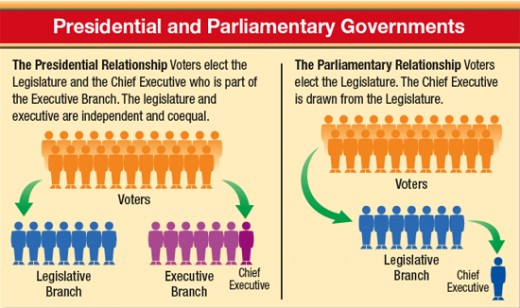The comparison between Presidential and Parliamentary democracy has always been an interesting and controversial topic for scholars of Political Science and especially those of Comparative Politics. Although European Westminster model of Parliamentary democracy has often been praised for being the right implementation of democracy by many thinkers, there are also many other scholars claiming the superiority of the presidential system.
Democracy can be basically defined as the government by the people or people’s right to govern themselves. Democracy was first appeared in ancient Greek city states called “polis”, where the economic welfare provided by the forced labor of slaves created a convenient environment for people to deal with sciences, to think and philosophize about the “just” and best way of government. At those ages, democracy could be exercised through the union of citizens in public squares. People were coming together on public squares, discussing and deciding on a specific policy. This is called as “direct democracy” and has become an inspiration and a model for modern democratic implementations like referendum and plebiscite. With the emergence of modern industrialized, highly institutional and organized empires and nation-states, direct democracy’s implementation became impossible and representative democracy model emerged. Representative democracy, through the selection of representatives by people, became the ideal form of democracy in time. The selection of representatives allowed people to make their wishes and complaints heard in the parliaments, assemblies and participate into decision making process through their representatives. However, to increase the satisfaction of democracy different ideas of Parliamentarism were put forward. Among these, Presidential and Parliamentary models gained widespread acceptance (also semi-presidential systems).
Parliamentarism is basically about people’s right to select their representatives and vote for political parties to select the Prime Minister. The Prime Minister is chosen from the parliament in parliamentary systems. The party or parties forming government determine the Prime Minister (usually the leader of that political party) and the parliament gives the vote of confidence. Prime Minister determines his deputies and the whole government tries to take the confidence vote of the parliament. We call this model as European Westminster model and it is applied in European countries and in Turkey. In Presidential system, people have right to choose their President and they vote for the candidate rather than the political party. People also choose their representatives in the Assembly but the president enjoys a much greater autonomy and chooses his ministers by himself. We see this model in USA and in Latin American countries.
Presidential versus Parliamentary governments
Juan Linz, a distinguished scholar of political science, in his writings always criticized Presidential system for many reasons and praised Parliamentary democracy as the ideal democratic model. Scott Mainwaring and Matthew S. Shugart summarized the five main points of Linz’s criticism in their article “Juan Linz, Presidentialism, and Democracy”.[1] Linz claims that the problematic nature of Presidential system is first caused by the separation between the Assembly and the government. In presidential systems, both Presidents and Assembly members are chosen by popular vote and they are not dependent on each other. According to Linz, this creates a problem of governance in Presidential systems especially when there are problems between the President and the Assembly. The party of the President may not constitute the majority in the Parliament and this may create problems. However, in Parliamentary systems, the Prime Minister is chosen from the Parliament and the Parliament has the right to change the Prime Minister by giving no confidence vote. Secondly, the fixed term of the President’s office introduces a rigidity that is less favorable to democracy in Presidential systems in Linz’s idea. In Presidential systems, President is elected and should stay in power during his term; the Assembly does not have the power to change the President. Thirdly, Presidentialism offers a strong element of zero-sum, “winner-take-all” into democratic politics which is also strengthened by SMDP (single member district plurality) electoral type. In contrast, Parliamentarism is based on coalitions, power sharing and consensus which are integral parts of democracy. Fourthly, the Presidentialism in Linz’s opinion means the identification of the entire nation and national interest with a man (or woman). Linz thinks that this is not in conformity with the idea of democracy and in addition, the President may act more intolerantly towards the opposition in this kind of a system. Lastly, Linz asserts that because of the loose ties between political parties and Presidents, Presidents may govern the country in a populist, anti-institutionalist fashion in Presidential systems. Linz also substantiates his arguments by giving statistical information showing that democracies are more likely to collapse in Presidential systems especially when there is a deadlock situation.
José Antonio Cheibub and Fernando Limongi on the other hand, in their article “Democratic Institutions and Regime Survival: Parliamentary and Presidential Democracies Reconsidered”[2] tried to refute Linz’s arguments. They first asserted that problems in the operation of the Presidential system cannot be entirely derived from the mode of the government formation. They claimed that Parliamentarism is based on majoritarianism, which is one of the central principles of democracy. Furthermore, in their idea, Parliamentary system has also many deficiencies. First of all, they thought that Parliamentary governments do not necessarily produce majority governments JDP’s case in Turkey after 2002 elections, having 34 % votes but also absolute majority in the Parliament). They gave statistical information claiming that minority government took place 22 % in Parliamentary systems between the years 1946 and 1999. Moreover, from their perspective, “deadlock” situations are extreme cases and they cause problems in Parliamentary systems too. Moreover, they claim that high party discipline in Parliamentary system prevents deputies to defend their constituents’ rights properly. Some decisions are taken from the party center and deputies are expected to give consent to these decisions. Mainwaring and Shugart also tried to refute Linz’s ideas about the Presidential system. They pointed out that dual legitimacy exists in Parliamentary systems too and crises may take place between upper and lower houses of a bicameral legislature. Moreover, they asserted that a Prime Minister using his/her decree powers do not have less autonomy than Presidents.
In my opinion, the problem in democratic systems is much deeper. Although representative democracy allows people to choose their representatives, mostly these representatives (political elite) form another class of rulers which causes a distance between voters and rulers. Issues concerning political elite force deputies from different parties to act together although they may be against people’s advantage. The hushing up of corruption files in Turkey is a good example for this. Similarly, the decisions about the wages of deputies in Turkey clearly show us that deputies and political parties in the parliament somehow start to act together and form another class. Deputies’ and political parties’ first aims become to stay in power or in the Parliament more than saying the truth or changing negative things in the country. Similarly, Prime Ministers or Presidents sometimes identify themselves with the national will and start to believe that they can do whatever they want. Democracy, although inapplicable in the direct form, should encourage and increase people’s participation into decisions and should not create a distance between people and power holders. However, I still believe that parliamentary model is better for a healthy democracy.
Some thinkers claim that Presidential system allows Presidents to enjoy high autonomy and things are done more efficiently in Presidential systems. They also criticize Parliamentary systems for creating a weaker executive and allowing anti-system parties to get into Parliament. However, democracy is a regime of consensus and the point should not be to handle things quickly, but rather to convince people about the rightness of doing things in that way. The problem of anti-system parties are tried to be solved by electoral thresholds in countries like Turkey. In these countries, a threshold barrier is invented in addition to proportional representation electoral system. I think that again democracy’s aim should be to allow all views including anti-system ones. Considering Kurdish question in Turkey, giving democratic rights and opportunities to opposing groups may decrease the terror and violent reactions. Another problem of both systems is that the Prime Ministers and Presidents may have the power of decree laws. This is totally against democracy and provides a leader to adopt laws to suppress the opposition.
Assist. Prof. Dr. Ozan ÖRMECİ
[1] Mainwaring, Scott & Shugart, Matthew (1993), “Juan Linz, Presidentialism, and Democracy”, Working Paper #200, July 1993, Kellogg Institute. Available at: https://kellogg.nd.edu/publications/workingpapers/WPS/200.pdf.
[2] Cheibub, José Antonio & Limongi, Fernando (2002), “Democratic Institutions and Regime Survival: Parliamentary and Presidential Democracies Reconsidered”, Annual Review of Political Science, Vol. 5, June 2002, pp. 151-179. Available at: http://www.yale.edu/leitner/resources/docs/2001-19.pdf.




















































